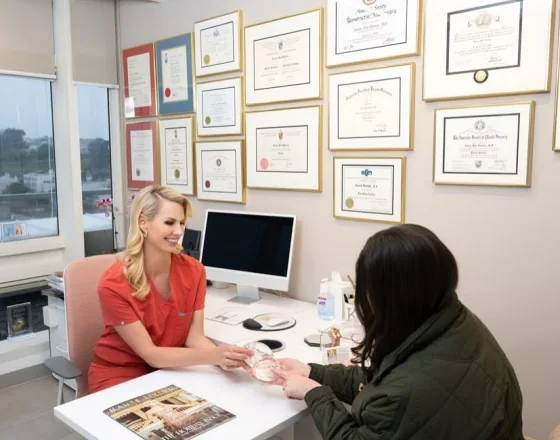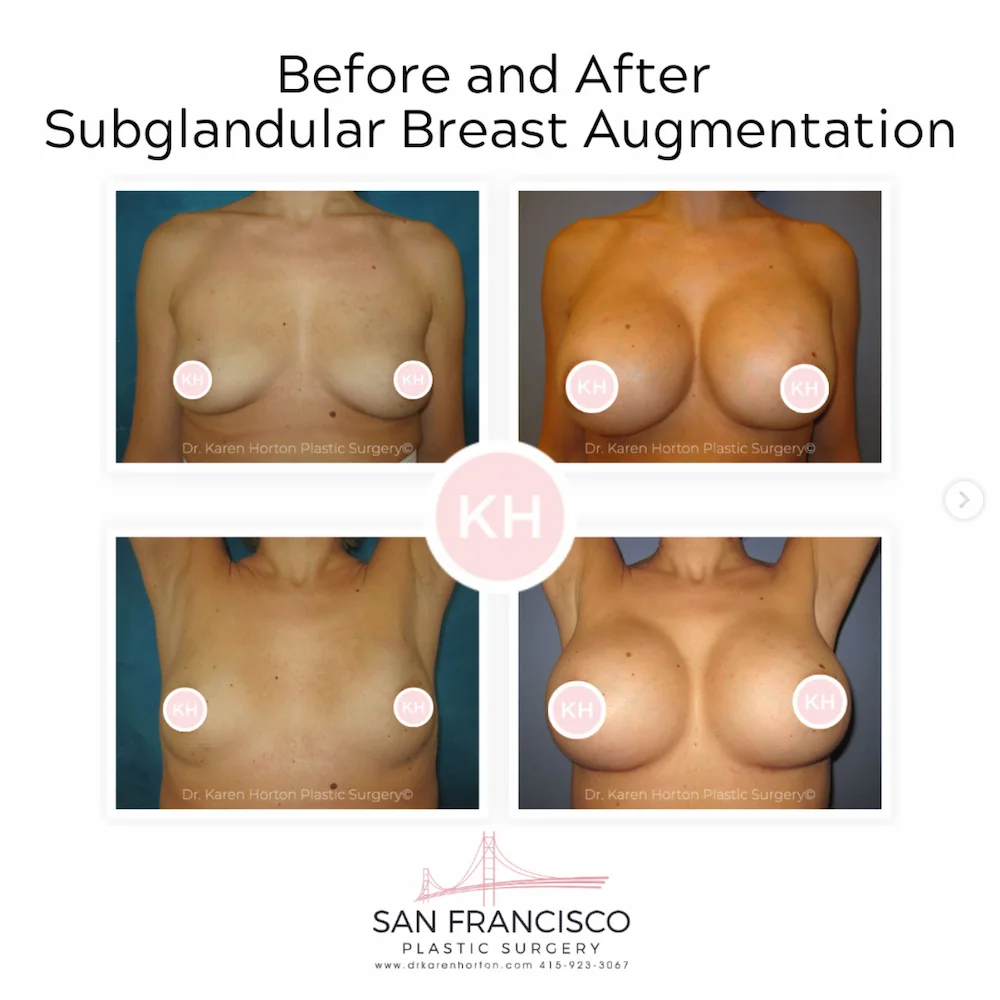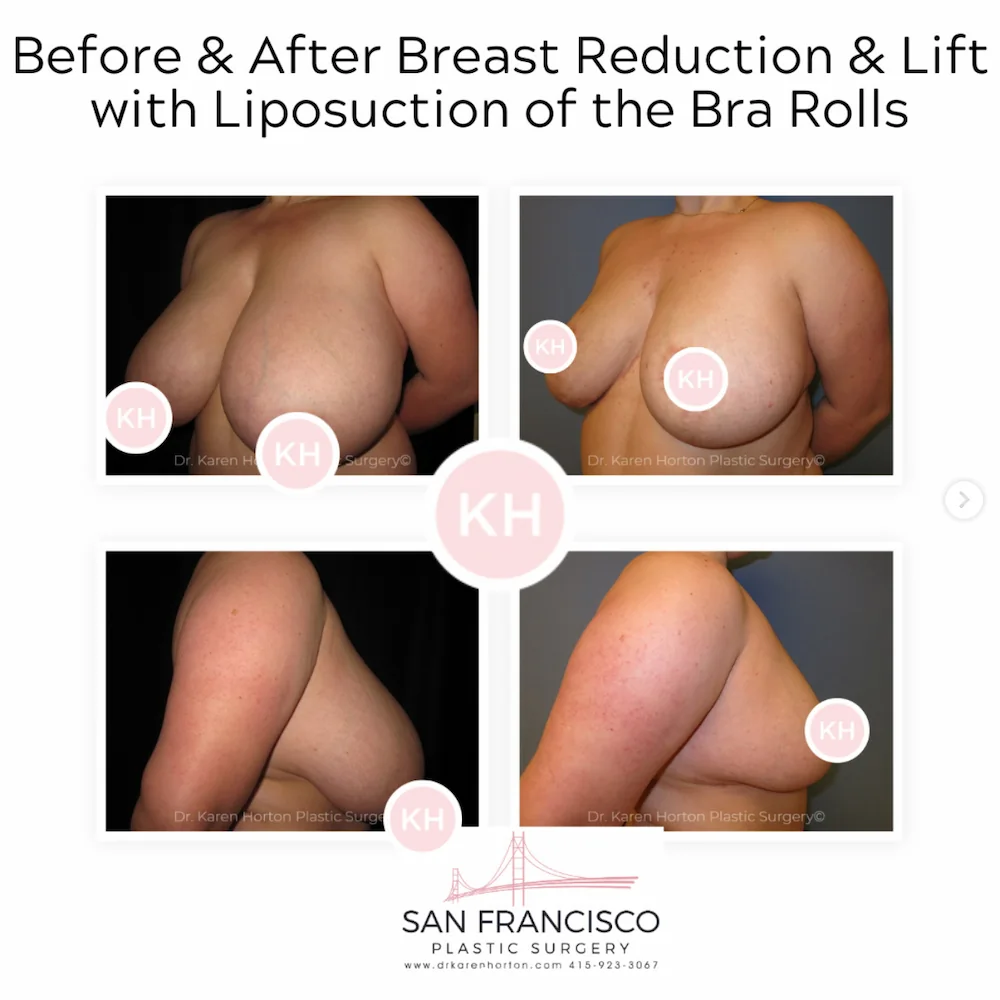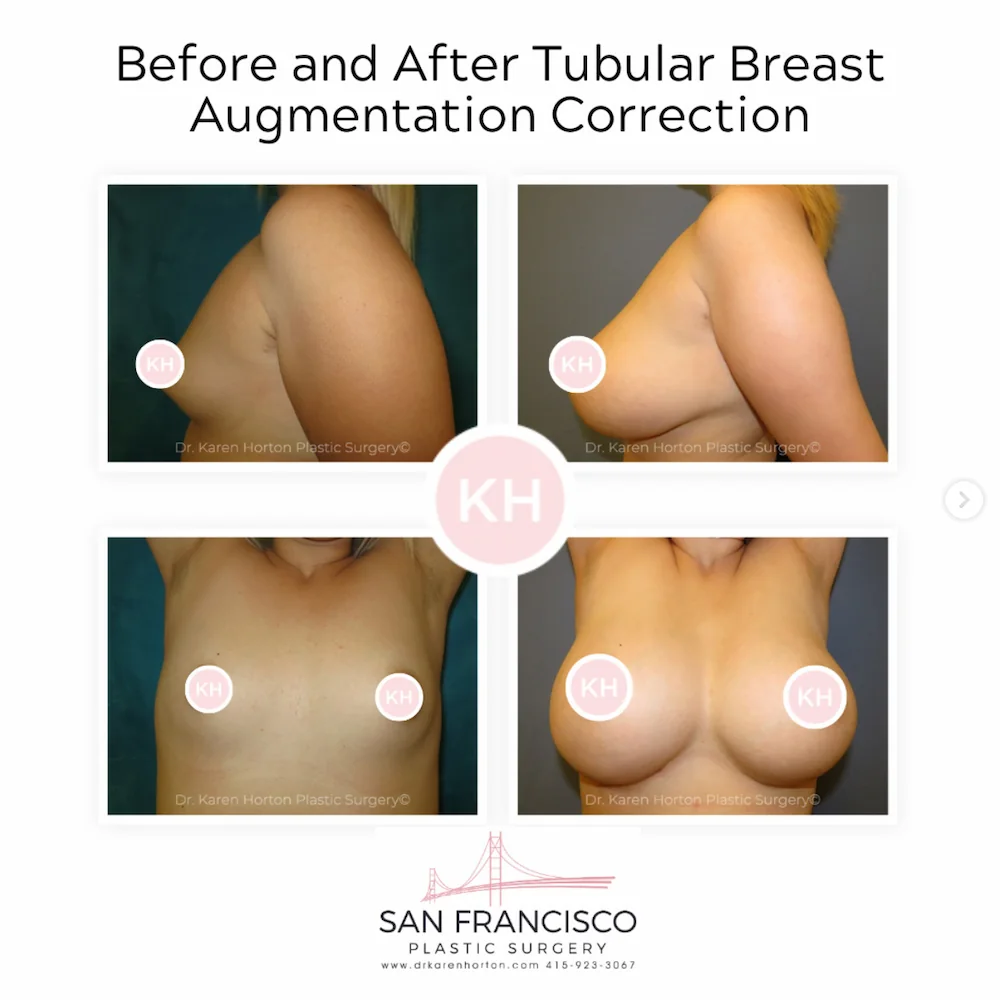The Health Benefits of Aesthetic Breast Surgery: Beyond Cosmetic Enhancement

By Dr. Karen Horton
When most people think about aesthetic breast surgery, they envision purely cosmetic transformations – enhanced curves, improved symmetry, or restored volume. However, recent groundbreaking research published in the Aesthetic Surgery Journal (2025) reveals that these procedures deliver profound health benefits that extend far beyond appearance, fundamentally improving patients’ physical, psychological, and emotional well-being.1
As a Board-Certified Plastic Surgeon, I’ve witnessed firsthand how aesthetic breast surgery transforms lives in ways that many patients never anticipated. The comprehensive health benefits documented in peer-reviewed medical literature demonstrate that these procedures address genuine medical concerns while simultaneously enhancing quality of life across multiple domains.
Understanding the Medical Foundation of Aesthetic Breast Surgery
Aesthetic breast surgery encompasses three primary procedures: breast augmentation, reduction mammaplasty (breast reduction) and breast lift/mastopexy, and tubular breast deformity correction. Each addresses specific medical conditions while providing substantial health improvements that have been validated through rigorous scientific research using standardized measurement tools like the BREAST-Q patient-reported outcome measure.
The 2025 study published in Aesthetic Surgery Journal analyzed thousands of patients across multiple procedures, revealing consistent patterns of health improvement that challenge the misconception that these surgeries are purely cosmetic. The evidence demonstrates measurable benefits in physical symptoms, psychological well-being, and overall quality of life that persist for years following surgery.
Breast Augmentation: Addressing Medical Conditions and Enhancing Well-being
Medical Indications for Breast Augmentation
Breast augmentation serves numerous medical purposes beyond aesthetic enhancement. The procedure addresses several legitimate medical conditions:
- Breast Aplasia and Amastia represent conditions where breast tissue fails to develop, often associated with Poland Syndrome, which affects chest wall development and can impact self-perception and physical function.
- Breast Hypoplasia and Hypomastia describe underdeveloped breasts resulting from hormonal imbalances, genetic conditions like Turner syndrome, or other medical factors that prevent normal breast development.
- Post-Pregnancy and Aging Atrophy occurs when breast tissue loses volume due to hormonal changes, breastfeeding, or natural aging processes, often causing significant psychological distress and affecting clothing fit and comfort.
- Breast Asymmetry affects up to 100% of women to some degree, with significant asymmetry causing physical discomfort, difficulty finding properly fitting clothing, and substantial psychological impact.
- Post-Cancer Breast Reconstruction helps restore breast appearance and body integrity following mastectomy or lumpectomy, playing a crucial role in cancer survivors’ emotional recovery and return to normalcy.

View more Breast Augmentation before and after photos in our website gallery.
Physical Health Benefits of Breast Augmentation
The physical benefits of breast augmentation extend beyond appearance enhancement:
- Enhanced Symmetry and Proportion: Improves posture and reduces strain on the back and shoulders, particularly in cases of significant asymmetry that can cause compensatory postural changes.
- Improved Clothing Fit: Reduces physical discomfort from ill-fitting garments and eliminates the need for padding or specialized undergarments that can cause skin irritation and discomfort.
- Restoration of Body Integrity: Following cancer treatment helps patients regain physical confidence and reduces the psychological burden of visible reminders of their illness.
Psychological and Emotional Health Benefits
Research consistently demonstrates significant psychological improvements following breast augmentation:
- Dramatic Self-Esteem Enhancement: Studies show 98% patient satisfaction rates with 91% reporting improved self-esteem following surgery. These improvements are sustained long-term, with benefits persisting for at least four years post-surgery.2
- Reduced Body Dysmorphic Symptoms: Patients experience significant decreases in body dysmorphic disorder symptoms, suggesting that surgery effectively addresses specific concerns and improves overall mental health.
- Enhanced Quality of Life: Improvements in self-esteem and body image lead to better social interactions, stronger romantic relationships, and improved overall mental health. Women report feeling more attractive and feminine, positively impacting their social and intimate relationships.3
- Improved Sexual Well-being: BREAST-Q studies demonstrate significant improvements in sexual function, with the majority of patients reporting better sexual well-being following breast augmentation.4
Reduction Mammaplasty: Life-Changing Relief from Physical and Emotional Burden
Medical Indications for Breast Reduction
Breast reduction addresses serious medical conditions that significantly impact daily life:
- Macromastia and Breast Hypertrophy: Cause chronic pain, postural problems, and limited mobility. Gigantomastia, defined as excess breast tissue contributing 3% or more to total body weight, represents the most severe form requiring surgical intervention.
- Functional Limitations: Include difficulty exercising, chronic shoulder grooving from bra straps, recurrent skin infections, and workplace productivity issues due to physical discomfort.
- Psychological Distress: From unwanted attention, social discomfort, and body dissatisfaction often carries the same weight as physical symptoms in determining surgical candidacy.

View more Breast Reduction before and after photos in our website gallery.
Comprehensive Physical Health Benefits
The physical relief provided by breast reduction is often life-changing:
- Significant Pain Relief: Systematic reviews of over 4,000 patients reveal statistically significant improvements in back, neck, and shoulder pain. The relief is often immediate and sustained long-term.5
- Headache Improvement: Many patients experience relief from tension headaches following breast reduction, with relief rates correlating to the amount of tissue removed.
- Postural Correction: Studies using radiological measurements demonstrate improved thoracic kyphosis, lumbar lordosis, and cervical lordosis angles following surgery. Better spinal alignment reduces associated discomfort and prevents long-term skeletal problems.6
- Enhanced Mobility and Physical Activity: Patients report increased willingness to exercise and participate in physical activities.
- Skin Health Improvements: Reduction in intertrigo, rashes, and infections under the breasts, along with elimination of painful shoulder grooving from bra straps.7
Psychological and Emotional Transformation
The psychological benefits of breast reduction are profound and well-documented:
- Improved Self-Esteem and Body Image: Validated using the Rosenberg Self-Esteem Scale, patients show significant improvements in self-perception and body confidence.8
- Enhanced Social Comfort: Reduced unwanted attention and improved social functioning allow patients to engage more comfortably in social situations.9
- Reduced Anxiety and Depression: Randomized controlled trials demonstrate significantly lower rates of depression and anxiety following breast reduction surgery.10
- Better Sexual Well-being: Systematic reviews show significant improvements in sexual desire and sexual well-being following breast reduction.11
- Improved Quality of Life: Multiple studies using validated tools like the BREAST-Q demonstrate substantial improvements across all quality-of-life domains.
Tubular Breast Deformity: Correcting Developmental Abnormalities
Understanding Tuberous Breast Deformity
Tubular, or tuberous, breast deformity affects breast development during puberty, creating a spectrum of abnormalities that significantly impact psychosocial development and body image. See a variety of preoperative tubular breast shapes here and results after tubular breast correction. This congenital condition involves subfascial constriction that limits normal breast expansion, resulting in:
- Narrower horizontal and vertical breast dimensions
- Elevated inframammary fold
- Enlarged areolar complex
- Deficient lower pole development
Health Impact and Surgical Benefits
Patients with Tubular breast deformity experience:
- Physical Challenges: Difficulty with breastfeeding and higher rates of obesity (74% overweight, 32% obese) compared to the general population.12,13
- Psychological Impact: Significantly lower self-esteem scores, higher embarrassment levels, and reduced scores in vitality, mental health, and social functioning compared to controls.14
- Surgical Correction Benefits: Studies show six- to nine-fold increases in breast satisfaction and two- to threefold improvements in psychosocial and sexual well-being following surgical correction.15

View more Tubular Breast Correction before and after photos in our website gallery.
The Science Behind the Benefits: Evidence-Based Outcomes
The health benefits of aesthetic breast surgery are validated through rigorous scientific research using standardized measurement tools:
- BREAST-Q Patient-Reported Outcomes: This validated measurement system consistently demonstrates significant improvements in psychosocial, physical, and sexual well-being across all breast surgery types.
- Long-term Follow-up Studies: Research tracking patients for multiple years confirms that benefits are sustained long-term, with many improvements actually increasing over time.
- Systematic Reviews and Meta-Analyses: Large-scale analyses of thousands of patients provide robust evidence for the health benefits of aesthetic breast surgery.
Addressing Common Misconceptions
Many patients and healthcare providers still view aesthetic breast surgery as purely cosmetic, but the evidence clearly demonstrates otherwise:
- Medical Necessity: Many breast surgeries address legitimate medical conditions that significantly impact quality of life and daily function.
- Insurance Coverage: Breast reduction is often covered by insurance when medical criteria are met, recognizing its therapeutic value.
- Long-term Benefits: The health improvements are not temporary cosmetic enhancements but sustained improvements in physical and psychological well-being.
Making an Informed Decision
If you’re considering aesthetic breast surgery, it’s important to understand that you’re not just investing in appearance – you’re potentially addressing significant health concerns and improving your overall quality of life. The decision should be based on:
- Thorough evaluation of your specific medical conditions
- Understanding of realistic outcomes and expectations
- Consideration of both benefits and risks
- Consultation with a Board-Certified Plastic Surgeon experienced in these procedures
Conclusion: A Comprehensive Approach to Health and Well-being
The evidence is clear: aesthetic breast surgery provides substantial health benefits that extend far beyond cosmetic enhancement. Whether addressing the physical burden of macromastia, correcting developmental abnormalities, or restoring breast volume after life changes, these procedures offer validated improvements in physical symptoms, psychological well-being, and overall quality of life.
As our understanding of these health benefits continues to evolve, it becomes increasingly important to view aesthetic breast surgery through a comprehensive health lens rather than dismissing it as purely cosmetic. For many patients, these procedures represent life-changing interventions that address genuine medical concerns while simultaneously enhancing confidence, comfort, and quality of life.
If you’re experiencing physical discomfort, emotional distress, or functional limitations related to your breast size, shape, or symmetry, consider consulting with a Board-Certified Plastic Surgeon to explore whether aesthetic breast surgery might provide the health benefits you’re seeking.
Frequently Asked Questions
Is aesthetic breast surgery covered by insurance?
Breast reduction is often covered by insurance when medical criteria are met, including documented physical symptoms and conservative treatment failure. Breast augmentation for reconstruction following cancer treatment may also be covered. Coverage varies by insurance provider and specific circumstances.
How long do the health benefits last?
Research shows that the physical and psychological benefits of aesthetic breast surgery are sustained long-term, with studies documenting continued improvements for at least four years following surgery. Many patients report that benefits actually increase over time as they adapt to their improved quality of life.
What makes someone a good candidate for aesthetic breast surgery?
Good candidates have realistic expectations, are in good overall health, have specific medical or psychological concerns that surgery can address, and understand both the benefits and risks involved. A thorough consultation with a Board-Certified Plastic Surgeon is essential to determine candidacy.
Are the psychological benefits really measurable?
Yes, the psychological benefits are measured using validated scientific instruments like the BREAST-Q, Rosenberg Self-Esteem Scale, and other standardized quality-of-life measures. These tools provide objective data demonstrating significant improvements in self-esteem, body image, and overall psychological well-being.
What’s the difference between cosmetic and reconstructive breast surgery?
The distinction often lies in the underlying indication rather than the surgical technique. Reconstructive surgery addresses medical conditions, developmental abnormalities, or cancer treatment effects, while cosmetic surgery primarily addresses aesthetic concerns. However, many procedures provide both medical and aesthetic benefits.
1 Reza Nassab, Mark Ho-Asjoe, The Health Benefits of Aesthetic Breast Surgery, Aesthetic Surgery Journal, Volume 45, Issue Supplement_2, September 2025, Pages S40–S46, https://doi.org/10.1093/asj/sjaf093. Accessed September 16, 2025.
2 Reza Nassab, Mark Ho-Asjoe, The Health Benefits of Aesthetic Breast Surgery, Aesthetic Surgery Journal, Volume 45, Issue Supplement_2, September 2025, Pages S40–S46, https://doi.org/10.1093/asj/sjaf093. Accessed September 16, 2025.
3 Jawanrudi P, Bender R, Pennig D, Taskin B, Schäller S, Al-Malat T, Mannil L. Evaluation of Quality of Life (BREAST-Q) and Scar Quality (POSAS) after Breast Augmentation. Plast Reconstr Surg Glob Open. 2022 May 18;10(5):e4313. doi: 10.1097/GOX.0000000000004313. PMID: 35620506; PMCID: PMC9116954. Available: https://pmc.ncbi.nlm.nih.gov/articles/PMC9116954/. Accessed September 16, 2025.
4 Jawanrudi P, Bender R, Pennig D, Taskin B, Schäller S, Al-Malat T, Mannil L. Evaluation of Quality of Life (BREAST-Q) and Scar Quality (POSAS) after Breast Augmentation. Plast Reconstr Surg Glob Open. 2022 May 18;10(5):e4313. doi: 10.1097/GOX.0000000000004313. PMID: 35620506; PMCID: PMC9116954. Available: https://pmc.ncbi.nlm.nih.gov/articles/PMC9116954/. Accessed September 16, 2025.
5 Chadbourne EB, Zhang S, Gordon MJ, Ro EY, Ross SD, Schnur PL, Schneider-Redden PR. Clinical outcomes in reduction mammaplasty: a systematic review and meta-analysis of published studies. Mayo Clin Proc. 2001 May;76(5):503-10. doi: 10.4065/76.5.503. PMID: 11357797. Available: https://pubmed.ncbi.nlm.nih.gov/11357797/. Accessed September 16, 2025.
6 Findikcioglu K, Findikcioglu F, Bulam H, Sezgin B, Ozmen S. The impact of breast reduction surgery on the vertebral column. Ann Plast Surg. 2013 Jun;70(6):639-42. doi: 10.1097/SAP.0b013e31823fac41. PMID: 23123605. Available: https://pubmed.ncbi.nlm.nih.gov/23123605/. Accessed September 16, 2025.
7 Chadbourne EB, Zhang S, Gordon MJ, Ro EY, Ross SD, Schnur PL, Schneider-Redden PR. Clinical outcomes in reduction mammaplasty: a systematic review and meta-analysis of published studies. Mayo Clin Proc. 2001 May;76(5):503-10. doi: 10.4065/76.5.503. PMID: 11357797. Available: https://pubmed.ncbi.nlm.nih.gov/11357797/. Accessed September 16, 2025.
8 Heller S, Mendoza Rebolledo C, Rodríguez Blázquez C, Carrasco Chillón L, Pérez Muñoz A, Rodríguez Pérez I, Martínez-Martín P. Validation of the multimodal assessment of capacities in severe dementia: a novel cognitive and functional scale for use in severe dementia. J Neurol. 2015 May;262(5):1198-208. doi: 10.1007/s00415-015-7692-9. Epub 2015 Mar 6. PMID: 25740664. Available: https://pubmed.ncbi.nlm.nih.gov/25740664/. Accessed September 16, 2025.
9 Chadbourne EB, Zhang S, Gordon MJ, Ro EY, Ross SD, Schnur PL, Schneider-Redden PR. Clinical outcomes in reduction mammaplasty: a systematic review and meta-analysis of published studies. Mayo Clin Proc. 2001 May;76(5):503-10. doi: 10.4065/76.5.503. PMID: 11357797. Available: https://pubmed.ncbi.nlm.nih.gov/11357797/. Accessed September 16, 2025.
10 Iwuagwu OC, Stanley PW, Platt AJ, Drew PJ, Walker LG. Effects of bilateral breast reduction on anxiety and depression: results of a prospective randomised trial. Scand J Plast Reconstr Surg Hand Surg. 2006;40(1):19-23. doi: 10.1080/02844310500415335. PMID: 16428209. Available: https://pubmed.ncbi.nlm.nih.gov/16428209/. Accessed September 16, 2025.
11 Janik PE, Charytonowicz D, Miszczyk J, Charytonowicz M. Female Sexual Function and Sexual Well-being Before and After Breast Reduction: A Pilot Cross-sectional Study and Review of Literature. Ann Plast Surg. 2019 Jun;82(6):609-613. doi: 10.1097/SAP.0000000000001742. PMID: 30557191. Available: https://pubmed.ncbi.nlm.nih.gov/30557191/. Accessed September 16, 2025.
12 Cruz, Norma I. MD. Type III Tuberous Breast Deformity and Breastfeeding. Plastic and Reconstructive Surgery 134(4S-1):p 167-168, October 2014. | DOI: 10.1097/01.prs.0000455554.45329.e2. Available: https://journals.lww.com/plasreconsurg/fulltext/2014/10001/type_iii_tuberous_breast_deformity_and.243.aspx. Accessed September 16, 2025.
13 Donnenfield JI, Nuzzi LC, McNamara CT, White AG, Labow BI. The Impact of Tuberous Breast on Adolescents: A Cross-sectional Study. Plast Reconstr Surg Glob Open. 2024 Jan 24;12(1):e5530. doi: 10.1097/GOX.0000000000005530. PMID: 38268714; PMCID: PMC10807874. Available: https://pmc.ncbi.nlm.nih.gov/articles/PMC10807874/?utm_source=chatgpt.com. Accessed September 16, 2025.
14 Donnenfield JI, Nuzzi LC, McNamara CT, White AG, Labow BI. The Impact of Tuberous Breast on Adolescents: A Cross-sectional Study. Plast Reconstr Surg Glob Open. 2024 Jan 24;12(1):e5530. doi: 10.1097/GOX.0000000000005530. PMID: 38268714; PMCID: PMC10807874. Available: https://pmc.ncbi.nlm.nih.gov/articles/PMC10807874/?utm_source=chatgpt.com. Accessed September 16, 2025.
15 Faure A, Mosca MV, Régas I, Pluvy I. Correction des seins tubéreux : évaluation de la satisfaction à long terme à l’aide du BREAST-Q [Tuberous breast deformity correction: Long-term satisfaction assessment with BREAST-Q questionnaire]. Ann Chir Plast Esthet. 2021 Dec;66(6):466-475. French. doi: 10.1016/j.anplas.2021.08.003. Epub 2021 Sep 23. PMID: 34563409. Available: https://pubmed.ncbi.nlm.nih.gov/34563409/. Accessed September 16, 2025.
